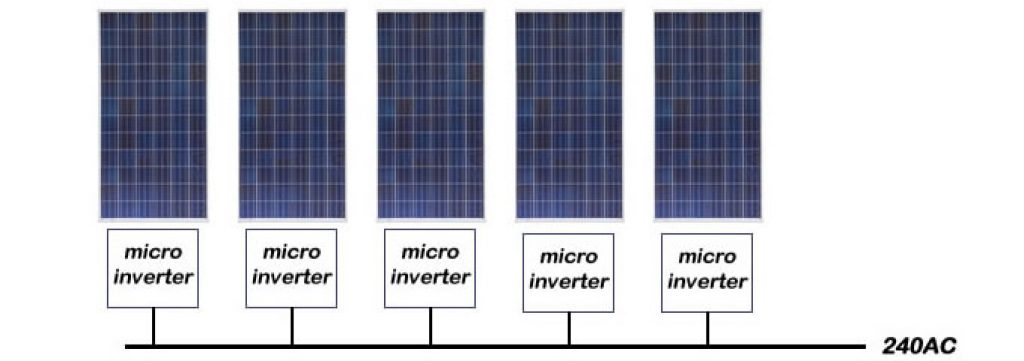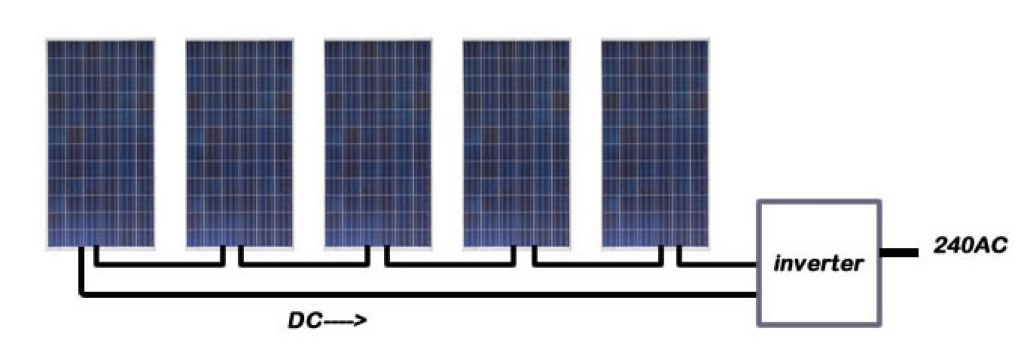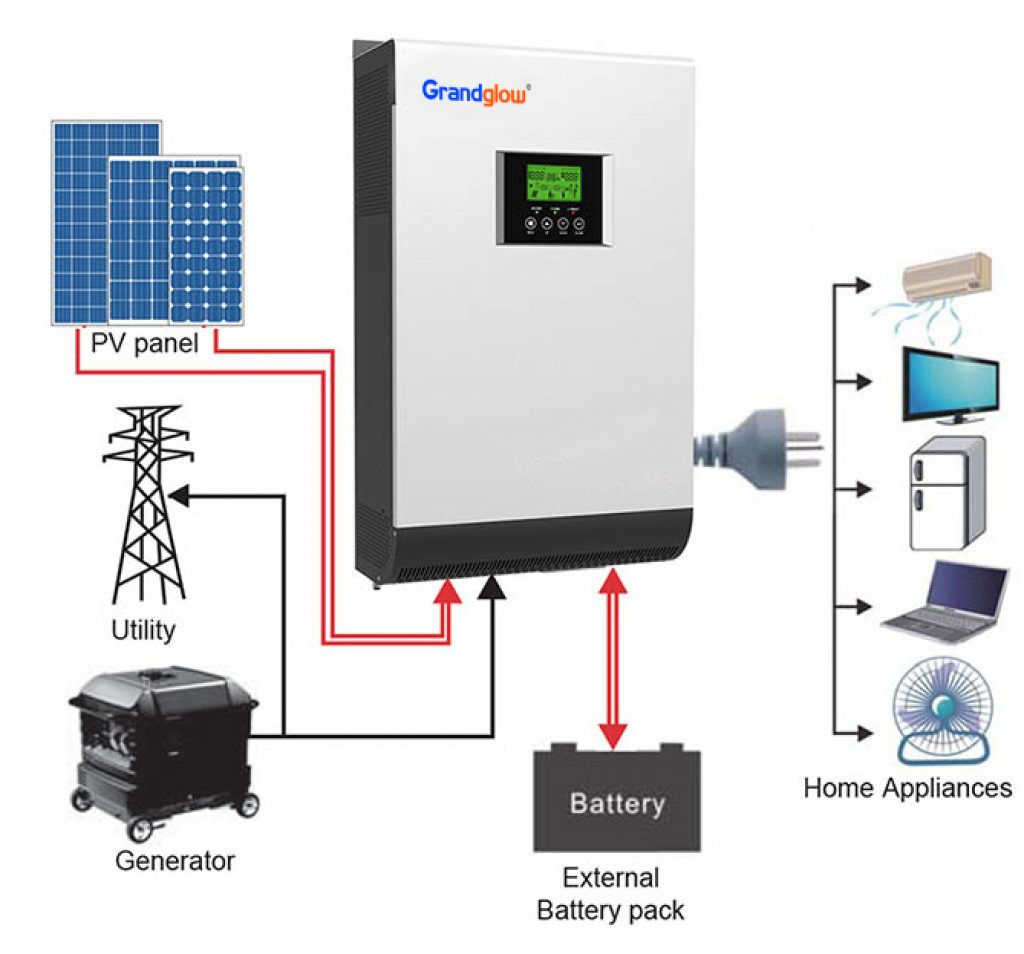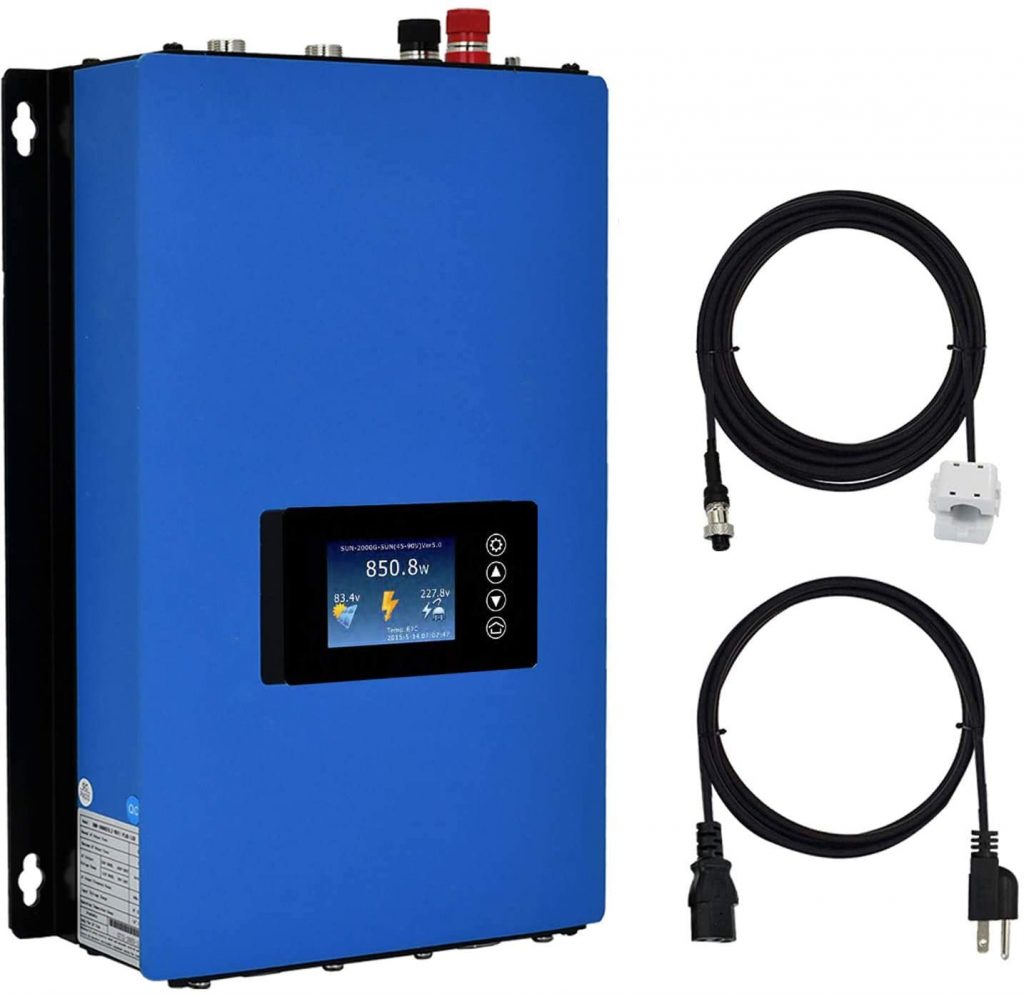Your solar panels are only as effective as the inverters they’re linked to. This makes the latter an incredibly valuable part of your solar system.
Inverters help your solar panels power your electronic devices by converting their direct current (DC) electricity into clean alternating current (AC), similar to the electricity from your utility company.
The three types of inverters compatible with solar panels include:
- Microinverters (grid-tied).
- String inverters (grid-tied).
- Hybrid inverters (off-grid).
Each of these inverters serves different needs and budgets.
In this article, we look at these inverters in greater detail and help you determine which suits you best.
In addition, we help you size your inverter for grid-tied and off-grid configurations.
Table of Contents
Types of inverters for solar panels
Inverters for solar panels differ slightly from DC to AC inverters that you use with 12V batteries or plug into your car’s cigarette lighter.
Your solar panels’ power output fluctuates throughout the day because of changing weather conditions and shading.
Because of these fluctuations, all inverters for solar panels include an MPPT solar charge controller that helps optimize solar production.
That said, the working principle of a solar inverter is similar to a regular pure sine wave inverter.
Overall, all solar inverters have the following characteristics:
- Durable: They can operate in a variety of climates.
- Reliable: They can operate continuously (always-on mode).
- Powerful: They are powerful enough to absorb your solar production and cover your power needs.
- Efficient: They can convert DC to AC at a +90% conversion rate.
Microinverters for solar panels
A microinverter is a small, individual inverter installed on each solar panel.
Each microinverter converts DC electricity produced by the panel into AC electricity that you can use in your home or business.
One of the main benefits of using microinverters is that they can increase the overall energy production of your solar panel system. Because each panel has its own inverter, shading or other performance issues with one panel do not impact the entire system’s output.
Moreover, microinverters can provide more granular control over energy production, which can be particularly useful in complex installations where panels are installed at different angles or orientations.

Another advantage of microinverters is that they can be more reliable than string inverters. Because each inverter is installed on an individual panel, the overall system is less susceptible to the weakest link effect that can impact the performance of a string inverter system.
Additionally, microinverters typically have longer warranties than string inverters, providing greater peace of mind for homeowners and businesses.
However, it’s worth noting that these inverters can be more expensive than string inverters, particularly for smaller solar panel systems. Because each panel requires its own inverter, the overall cost of the system can be higher.
Moreover, the installation process can be more complex than a string inverter system because the inverters are installed on the roof with the panels.
String inverters for solar panels
A string inverter is one of the most commonly used types of inverters for solar panel systems. It works by connecting multiple solar panels in a series, or “string,” and converting DC electricity produced by the panels into AC electricity you can use throughout your home.
A significant advantage of string inverters is that they are cost-effective solutions for larger solar panel systems.
Because multiple panels are connected in a string, only one inverter is needed to convert the DC electricity to AC. This helps you save on installation and equipment costs.

However, they do have a potential drawback. If one of your panels in the string is shaded, dirty, or malfunctioning, it can impact the performance of the entire string. This is because the output of a string inverter is limited by the strings lowest-performing panel.
Some string inverters are equipped with technologies such as Maximum Power Point Tracking (MPPT) to address this issue. MPPT tracking can optimize the output of individual panels in a string to minimize the impact of shading or other performance issues.
Hybrid inverters for solar panels
A hybrid inverter is an advanced type of inverter capable of managing both grid-tied and off-grid power systems. Unlike traditional inverters, hybrid inverters can be used in various power systems, making them a more versatile and cost-effective option for many users.
A hybrid inverter typically consists of two main components:
- DC-to-AC inverter: The DC-to-AC inverter converts DC electricity produced by solar panels into usable AC electricity.
- Battery charger: This component charges batteries using AC electricity from the grid or renewable energy sources.

Hybrid inverters also have built-in capabilities to manage energy flows between the grid, renewable energy sources, and batteries. This means that they can automatically switch between different energy sources depending on the availability and demand of power.
For example, when solar power is abundant, a hybrid inverter can use the excess energy to charge batteries or power household appliances. Conversely, when solar power is unavailable, the hybrid inverter can draw energy from the grid or batteries to power the household.
In addition, if there is a power outage, a hybrid inverter can automatically switch to battery power to ensure critical appliances such as refrigerators or medical equipment continue functioning.
Most models also allow an external AC source (fuel generator) to take over in case of a power shortage from the batteries and solar panels.
What type of inverter do I need for my solar system?
This section will describe the main features of each solar inverter and give you our recommendation.
Microinverters

In a solar system, you can count as many micro-inverters as the number of solar panels. Therefore, each panel is individually monitored and controlled.
Average price: $0.3/watt
Should you use a microinverter?
In the end, micro-inverters are recommended for domestic solar production only. Their high level of durability and efficiency are greatly appreciated and result in cost savings over time.
String inverters

Unlike micro-inverters, you only need one string inverter to control your solar array. Usually, a string of solar panels in series produces high DC voltage (from 120V to 500V DC) to the string inverter, which converts it into AC (110V/220V).
Average price: $0.2/watt
Should you use a string inverter?
Central string inverters are convenient to install and maintain, but they suffer from low efficiency if local shading occurs (up to 25% loss).
In most cases, solar panels are connected in series to the inverter. Therefore, if one solar panel is shaded, the whole string of panels is affected, and so is the power output.
That being said, central inverters are recommended for domestic solar systems, especially because they are affordable and easy to maintain.
Hybrid inverters

Hybrid inverters are string inverters that include a battery charger and a smart energy management system. They are versatile and can be installed even if you can access grid electricity.
Average price: $0.25/watt
Should you use a hybrid inverter?
Hybrid inverters are the most versatile inverters. They give you the ability to run your own power station without the need for external grid power. They are best for situations where the electrical grid is absent — camping, RV’s, boat, and off-grid houses, in combination with quality lithium batteries.
Some brands already offer integrated systems, including off-grid inverters and batteries in a plug-and-play solution called an Energy Storage System (ESS).
What size inverter do I need for my solar system?
This section teaches you how to size your inverter in grid-tied and off-grid configurations.
Inverter size for a grid-tied configuration
Don’t fear running out of power when connected to the utility grid; if your solar production is insufficient, the grid will supply your power. In that case, the size of your inverter is related to your solar array’s total peak power.
You should oversize your inverter capacity by 30% compared to the total solar panel peak power.
Inverter size = TotalPV Peak Power * 1.3
For example, if you want to install six, 400W solar panels (2400W), we suggest purchasing a top-quality 3000W inverter.
Remember that a larger string inverter allows you to add extra solar panels later.
What Size Of Inverter Do I Need In an Off-grid Configuration?
In an off-grid system (boat, RV’s, camping, cabin…), there is no grid backup in case of power shortage.
You should oversize your inverter by 40% to 50% relative to your peak power needs. This is because some appliances (refrigerators, water pumps, power tools, etc.) are reactive loads that require more power to start and operate than their rated power.
Other appliances are resistive loads that only need their rated power (TV, computers, lights…).
Inverter size = Total Appliances Power*1.5
To give you an idea, we have summarized different appliances that you could run simultaneously with a 500W, 1000W, 1500W, and 3000W hybrid inverter:
| LED TV (100W) | Electric Fan (60W) | Laptop (150W) | Refrigerator/freezer (100W) | Vacuum cleaner (700W) | Led lights (6*5W) | Electronics (phone, tablets, 25W) | Water pump (1kW) | |
|---|---|---|---|---|---|---|---|---|
| Inverter 500W | + | + | + | + | + | |||
| Inverter 1000W | + | + | + | + | + | + | ||
| Inverter 1500W | + | + | + | + | + | + | + | |
| Inverter 3000W | + | + | + | + | + | + | + | + |
Related reading:
Final thoughts courtesy of Koos Mulder
We reach out to an expert in solar off-grid systems, Koos Mulder. Koos is installing micro-grid systems in remote villages throughout the Philippines for the Shell Foundation.
According to Koos:
Microinverters are a great choice for AC coupled systems (grid-tied) thanks to their high efficiency. However, he brought attention to two issues:
- Safety: The back of a solar panel get very hot (+60°C). The more inverters you have (one per panel), the greater the risk of an electric fire.
- Maintenance: While you may not need to perform maintenance for years, it can be complicated to determine where the defective micro-inverter is when you eventually do.
Overall, Koos favors central hybrids inverters as they are much easier to install and control and are ultimately cheaper. They may be slightly less efficient (-5%), but this is all balanced by all the previous advantages.
Ultimately, the current trend is geared towards energy storage at home, combining smart inverters and solar batteries in the form of ESS solutions.
Electricity consumers will turn into prosumers, to sell their excess electricity to the grid when prices are high.
Doing this can achieve more renewable energy in our global electricity production.

